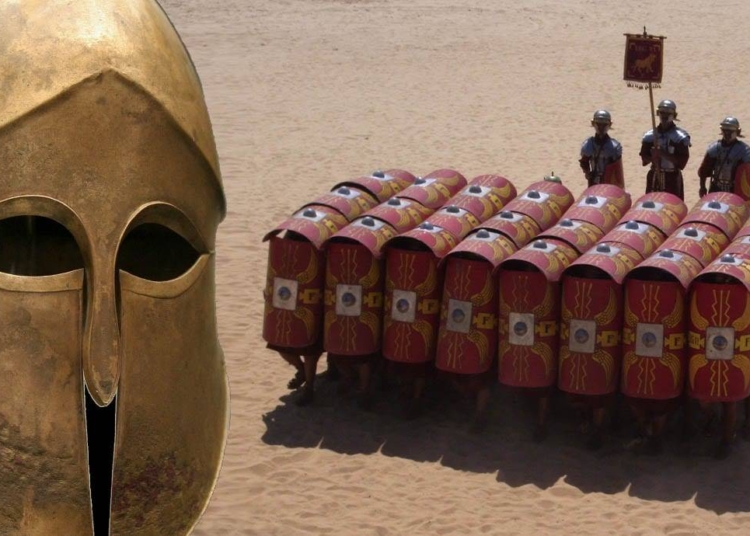The Macedonian Phalanx was an incredibly formidable formation in ancient warfare. Developed by Alexander the Great, it served as the backbone of his armies and led to numerous victories. The formation consisted of heavily armored soldiers called hoplites, armed with the long spear known as the sarissa. Standing in tight ranks with overlapping shields and spears extended forward, the phalanx was virtually impenetrable. Its strength lay in its cohesion and discipline, allowing it to withstand any frontal assault and create havoc on the battlefield. The sarissa’s length and reach gave the phalanx a significant advantage, making it nearly impossible for enemies to break through. The phalanx played a critical role in Alexander the Great’s conquests and inspired fear among his enemies. Despite its strengths, the phalanx had limitations, such as vulnerability to flanking maneuvers and restricted spaces. Its legacy can be seen in subsequent military formations, even in present times. The Macedonian Phalanx is a symbol of ancient military prowess and the brilliance of Alexander the Great.
The Macedonian Phalanx: Unstoppable Formation of Ancient Warfare
Introduction
In the annals of ancient warfare, no formation was as formidable and unstoppable as the Macedonian Phalanx. Developed and perfected by the great military genius, Alexander the Great, this formation served as the backbone of his armies and ensured his numerous victories across the known world. The Macedonian Phalanx revolutionized warfare tactics and was a significant factor in the rise of the Macedonian Empire.
Formation and Tactics
The Macedonian Phalanx was an infantry formation consisting of heavily armored soldiers called “hoplites” armed with a long spear called the “sarissa.” The soldiers would stand in tight ranks, typically eight men deep, with their shields overlapping to create a virtually impenetrable wall of bronze. The sarissa, which measured up to 18 feet long, was held with both hands and extended forward, making it difficult for enemies to approach with their shorter weapons.
The strength of the phalanx lay in its cohesion and discipline. The soldiers had to act as one unit, moving, pushing, and thrusting in unison. This required intensive training and drilled discipline, making the Macedonian soldiers markedly superior to their adversaries. A well-functioning phalanx could withstand any frontal assault, sweep through enemy lines, and create havoc on the battlefield.
The Impact of the Sarissa
One of the most crucial components of the Macedonian Phalanx was the sarissa. Its length and reach gave the phalanx an incredible advantage over other infantry formations of the time. The front rows of the phalanx would extend their spears beyond the first row, creating multiple barriers. This made it nearly impossible for enemies to break through the phalanx’s wall of spears.
Moreover, the sarissa enabled the phalanx to push and repel enemies with ease. The soldiers could thrust their spears forward, using them as a deadly pike wall against both infantry and cavalry. The length of the sarissa acted as a deterrent, preventing enemies from getting too close, and allowed the phalanx to strike from a relatively safe distance.
Historical Significance
The Macedonian Phalanx played a critical role in Alexander the Great’s conquests, displaying its power and effectiveness against various adversaries. From the Battle of Chaeronea in 338 BC, where the phalanx crushed the combined forces of Athens and Thebes, to the famous Battle of Gaugamela in 331 BC, where Alexander’s phalanx defeated the Persian army, the formation proved its superiority.
The phalanx also inspired fear and awe among Alexander’s enemies. Its imposing appearance and solid ranks intimidated opposing forces, often leading them to avoid direct confrontation. The Romans, recognizing the immense power of the phalanx, later adapted it into their own military tactics, integrating it into their renowned legions.
Limitations
Despite its unparalleled strength, the Macedonian Phalanx had some limitations. Its effectiveness relied on maintaining tight formations and disciplined soldiers. When faced with unconventional tactics, such as flanking maneuvers or attacks from multiple angles, the phalanx became vulnerable. Additionally, rough terrain and restricted spaces limited the phalanx’s effectiveness, as it required enough space to maneuver and maintain its formation.
Legacy
The legacy of the Macedonian Phalanx extends far beyond the time of Alexander the Great. Its influence reverberated across ancient warfare, and elements of the phalanx can be seen in subsequent military formations. The Romans, as mentioned earlier, adopted aspects of the phalanx, integrating it into their renowned legions. Even in present times, modern military formations, such as the square formation used in the Napoleonic era, echo the principles of the Macedonian Phalanx.
Conclusion
The Macedonian Phalanx stands as an emblem of the military prowess of ancient Macedonia and the brilliance of Alexander the Great. Its revolutionary tactics and unstoppable formation changed the course of history and paved the way for future military strategies. The phalanx, with its disciplined soldiers and formidable sarissas, left an indelible mark on ancient warfare, forever etching its name in the annals of military history.












